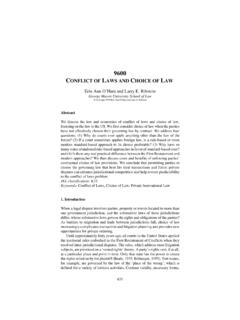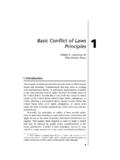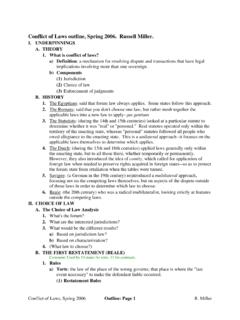Transcription of I. Problems in Choice of Law-
1 conflict of laws - Appleton Outline- Spring 1999. I. Problems in Choice of Law- Problems in Choice of law occur in cases that involve multiple jurisdictions and the laws of those jurisdictions are different. Choice of law describes the process and rules used by a court to determine which law should be applied to the present case. Courts have used a number of approaches to determine which law should be applied considering a variety of factors. Despite the variety of approaches, most courts apply the traditional theory discussed below. A. Overview- conflict cases involve any number of complicated issues, however the basic pitfalls and judicial policy are similar: 1. Basic Problems - Conflict of law Problems arise in three areas that related to the power of the deciding court to make a decision and the decision itself. a) Choice of Law- the court must face the issue of under what circumstances the court will set aside its own law to apply the law of another jurisdiction.
2 B) Jurisdiction- the court also faces the issue of whether the court has the power to render the decision over the parties (personal jurisdiction) and the dispute itself (subject matter jurisdiction). c) Recognition of Judgments- where should a court adopt the judgment of another jurisdiction in a matter and extend it to its own jurisdiction. (Issue Preclusion/Res Judicada). 2. Basic Principles- the answer to these Problems is geared to address the following concerns that are basic to political and judicial policy. Any conflicts of law determination should attempt to maximize the following: a) Sovereignty- recognizes the states interest in and right to control activity within its borders. Specifically, the actions of it citizens within the state and outside of it and non-residents while within the state or conducting activities that affect the state. b) Comity- where a states own interests are not affected by a case, the state should afford deference to the policies of the states who policies are implicated in the matter.
3 C) Consistency- the court should always seek to have a consistent result. Outcome should not be dependant on forum avoid encouraging forum shopping. B. First Restatement-- Traditional Theory- the original source of Choice of law is the first restatement on conflict of laws . This approach is characterized by a strong focus on physical location. Historical Choice of law decisions were often justified on territorial sovereignty rights. 1. Place of Wrong- Lex Loci Delecti- for torts and related actions, the law of the place of wrong will govern, this will typically be the place of injury. The law will be applied to all issues of the case, regardless where other events took place. a) Determining Place of Injury- the place of injury will be considered to wear the actual damage occurs, even if the conduct resulting in the injury occurred in another state. (AL South RR v. Carroll) For poisoning, where the poison takes effect. b) Place of Conduct- the place of conduct may be used in situations where the standard of care is at issue or for claims of privilege/immunity.
4 AMH Page 1. conflict of laws - Appleton Outline- Spring 1999. 2. Place of Contract- Lex Loci Contractus- under the traditional approach all disputes over a contract were to be settled based on the law of the place where the contract was made. (Milliken v. Pratt) Courts will often use to law of the forum to define where the contract is made. a) Place of Making- many times the place of the contract is determined by where the meeting of the minds' occurred. This is law will be applied to issues of validity. b) Place of Performance- the court will use the law of the place of performance where the issue arises out of an issue of performance (nonperformance, breach, damages, etc.). 3. Physical Location- Lex Loci Situ- under the first restatement, state sovereignty is recognized as a primary issue in Choice of law. As a result, where property or persons are located within the states borders, the restatement applied the law of that state.
5 A) Situs of Real Property- real property will be governed by the law of its location. Local law preference in matters regarding local property is so strong that laws regarding b) Moveable v. Immovable- where property is movable (as determined by forum law). the Choice of law issue becomes more complex. 1) Wills/Intestate moveable items are governed by the domicile of the testator at death. 2) Situs rule for other transactions the law of the location the chattel is to be aplied under the traditional approach. c) Domicile- domicile is a legal fiction designed to attach a person to a specific states jurisdiction. A domicilliary will be subject to general jurisdiction in the state of his domicile. The domicile of a person is typically determined by the law of the forum. 1) Types of Domicile- domicile is different than residence, a person may have more than one residence, but can only have one domicile. There are three basic manners that a person can acquire or change a domicile: Domicile of Origin- a person who is born takes the domicile of his/her parents at birth.
6 This will continue until the person is legally capable of establishing their own domicile. Domicile of Choice - this is a person's legal home and is characterized by presence with intent to remain indefinitely. Domicile by Operation of Law- historically, a married woman would take the domicile of her husband upon marriage, although not today. Also minors and incompetent persons may have their domicile legally determined. AMH Page 2. conflict of laws - Appleton Outline- Spring 1999. 2) Changing Domicile- a person must have a domicile, the domicile may be changed, but until changed, the person will be considered to keep their past domicile. Must Arrive at New Domicile- in order to establish a new domicile, a person must have been physically present at the new domicile at some point. (White v. Tennant). Change Cannot be Compelled- a person cannot be compelled to change his domicile even where compelled to change residence, this is often an issue with prisoners and persons who are in military service.
7 D) Marriage- typically a marriage will be considered to be valid wherever it was valid within the laws of the place of celebration. There may be some exceptions discussed infra regarding same-sex, incestuous, or bigamous marriages based on the public policy exception. C. Escape Devices- Avoidance of Foreign Law- in order to avoid applying a law the court may find unjust (typically a foreign jurisdictions, but occasionally their own law), under the traditionally systems have used a number of escape devises to apply a different law than what may seem to be plainly compelled by the restatement. 1. Characterization- the most common escape device is in the characterization of what area of law a case is ( property, contract, tort, family etc.) which directly determines which law will apply. This is largely a necessary evil under any conflict of law rules and cannot really be avoided. 2. Substance/Procedural- a second form of characterization issue is the distinction between substantive and procedural issues.
8 This is important because a court will apply the procedure of the forum and the substantive law based on Choice of law. Generally, procedural issues are considered to be an inconvenience for the forum to follow and not to outcome determinative, however is some situations they have a noticeable effect on the outcome. a) Statute of Limitations- traditionally, the statute of limitations on an action was considered to be a procedural matter that was controlled by the forum of the litigation. This has the effect of encouraging forum shopping, as a result may forums have adopted borrowing statutes that are discussed below. b) Limits on Damages-traditionally limits on punitive or other damages have also been treated as substantive rather than procedural. However that rule has not always been followed by courts: 1) Right v. Remedy- some courts have held that the amount of damages is a matter of remedy that should be determined by the forum rather than a matter of right which is governed by substantive law.
9 2) Public Policy Exception- some jurisdictions have set aside limits on damages of another jurisdiction on a public policy basis that it is against the forum states public policy to limit remedy in such a way. 3. Renvoi- is a concept describing the use of a foreign jurisdiction's whole law, including its Choice of law rules. Applying the state's Choice of law rules is AMH Page 3. conflict of laws - Appleton Outline- Spring 1999. referred to as accepting the renvoi, not is considered rejecting the renvoi. A. primary reason for the use of renvoi is to avoid a situation where State A is applying State B's law to a case, even though State B would apply State A's law under its Choice of law rules. a) Real Property = Renvoi- the only area in which renvoi has gained acceptance on a wide scale is in matters regarding real property. This based on the strength of interest of the forum in applying its whole law to property located within its jurisdiction.
10 B) The Endless Circle Problem- one problem of Renvoi has been the potential for an endless circle in a situation where State a says look to the whole law of State B and State B's law says to use State A. This is prevented by stopping the bounce'. between the two states after either after the initial reference or after the reference back to the forum state. This solution as criticized as an arbitrary determination to stop ( why stop after one or two bounces? Why not 3, 6, 73, ). 1) One Bounce- If State A's applies B's whole' law and state B's law bounces back to state A. Then State A applies its law. 2) Two Bounce- If State A applies B's whole' law and state B's law bounces back to state A, then A's law bounces back to B's whole' law, State B's law is applied. c) Majority Rejects- the result of this problem is that a majority of jurisdictions reject the French concept of renvoi and do not apply the whole law of a jurisdiction when told to look there by conflict rules.










